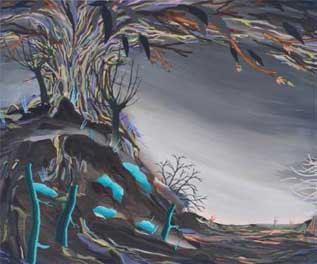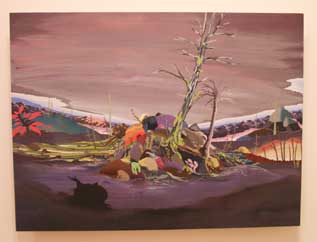
|
||
|
Portland art blog + news + exhibition reviews + galleries + contemporary northwest art
|
||
Adam Sorensen's The Glows at Elizabeth Leach Gallery  Adam Sorensen's Rusty Pine (2007) In the 90's Takashi Murakami articulated the hyperactivity of Otaku (Japanese geek) culture and coined the term Super Flat to embody its leveled and interchangeable conflation of commerce and art. In 2001 an exhibition by the same name toured three museums west of the Mississippi; MoCA in LA, The Walker Art Center in Minneapolis and the Henry in Seattle. It shook visual culture in a way that no other exhibition during the 80's or 90's can claim. Prior to that, some of Murakami's lactating and ejaculating sculptures appeared at the Portland Art Museum for the "Let's Entertain" show in 2000. A large contingent of artists in Portland took it all very seriously; there was something about its mélange of tongue in cheek pop cheer, coupled with a nihilist zeitgeist that appealed to a city in the throws of the dot com boom.  Sorensen at Liz Leach Adam Sorensen was among those who absorbed Japanese culture in depth, while avoiding anime's cute big eyed figurative elements. I remember calling his cell phone for the first time only to be greeted by a crazed announcer voice stating, "You've reached Ad-dam Sor-en-sen the amazing Hiroshigi wannabe." Funny stuff, no he isn't Hiroshigi but he did share his interest in evocative nature.  Caspar David Friedrich's Solitary Tree The Northwest (which has closer ties to Japan than New York) is also a major keeper of the northern European landscape tradition from Rubens, Jacob van Ruysdael and Caspar David Friedrich to Ernst Ludwig Kirchner and maybe even Anselm Kiefer? Still, area artists like James Lavadour and Michael Brophy have a romanticism that leans more towards sumi ink paintings than Murakami's complicated pop. Sorensen might be important because he bridges the generation gaps stylistically with a kind of pop romanticism. Somehow I keep thinking of the music of Jean Sibelius, woodland anime like the opening sequence of Princess Mononoke and of course the smurfs when I see Sorensen's new work.. What is good is there are no trolls, discernable historical references or figures to turn this into fantasy "Gandolf save us" drivel. It's pop romanticism and related to expressionism without being too derivative of either. Sorensen is also part of a talented group of Alfred University grads ( Paige Saez, Megan Walsh, Amanda Wojick, Kristan Kennedy, Corey Lunn and Sean Healy) who descended on Portland in the last 10 years (many were from the same class). It was an important developmental peer group that has bourn fruit. Over the years Sorensen's style has tried to bridge the gap between the romance of natural forms and pop culture's arid ambivalence coated in candy colors. The city of Portland itself is constantly in a romantic struggle between the overwhelming nature of Forest Park/volcanoes (both within the city limits) and the design firm/real-estate hotness that has everyone wondering if PDX's boom will become as sad as San Francisco's endangered middle class. In Portland the twin poles of design culture and nature are incredibly entwined while remaining in tension in a way that Hiroshige could have appreciated. By 2003 Sorensen had been curated into the Oregon Biennial and Core Sample (by yours truly). He was good but not fully developed. His work had a Gary Hume like flatness of field and a precious floral quality that seemed undistinguished if appealing. It felt like an opaque projection only a few steps away from wallpaper but it had a tension that kept it alive. The surfaces were also a little overworked too. Basically, he was a talented painter who hadn't reached his full potential. Now its 2007 and 3.5 years since the last time we've seen more than 2 of his paintings on a wall and Sorensen has his big debut at what is arguably Portland's top contemporary gallery. Sure he's paid some of his dues but the real story is the work. The most obvious change is the work has become a traditional landscape with foreground and background.  Mid-Alp (2007) Works like Mid-Alp have a traditional lone tree in the front with mountains in the back. It isn't all happy trees ala Bob Ross though, there is a big stump giving the psychedelic colored flora a wistful sense of loss. Also, the winds are blowing hard too and though this is unabashedly fantastic it's full of brooding even threatened leafless trees on an inhospitable and cloudy mountain pass. A tiny sapling rises from the stump and my first reaction was to dislike it's sentimentality but the picture is too well done to be stunted by it. One of the smaller paintings Sprigs crosses the sentimental line though with its too anthropomorphic and sentimental trees. In that painting one tree looks like it's shielding the other or possibly offering it a plate of cookies (ugh).  Grand Charteuse (2007) In other works like Grand Charteuse the composition is definitely more allegorical. The central tree is surrounded by will-o-the wisps of paint while a deathlike sentinel of a mountain peak looms behind. Some of the trees have leaves but the central one is still convalescent. One could read this as a comment on political leadership just as the eternal winter in The Lion the Witch and the Wardrobe related to Britain during the Blitz.  Dark Knoll (2007) The use of evocative trees is an old device popular with Caspar David Friedrich and Goya. They have also been popular in films like The Legend of Sleepy Hollow and the third Harry Potter film but most of these painted trees lack that kind of personality. For example, the tree in Grizzly is merely grizzled and the tree in Dark Knoll acts more as a foreboding framing device than an actual persona, though that slightly creepy but undefined presence makes it one of the more interesting paintings in the show.  Northern (2007) Similarly unexplained but even more memorable the dead tree in Northern tilts to the left. Is it a phantom monolith in a psychedelic forest fire aftermath? There is also a massive stump whose scale is confusing in a good way. The best part though are the odd whitish highlights all over the tree which also drip from the sky… is this the work of phantom lichens or mold? Somehow a forest scene that looks like it's been left in the back of a fridge for a few months is really interesting. The best paintings though are warm and generous. Rusty Pine has cool colored plants bursting into the foreground while tree roots hold a cliff face from falling into a precipice. It's classic romanticism and it yet feels like honest art of the moment, whereas On Tops feels more like a decorative technical victory lap in comparison, good but less complicated.  The Lumps (2007) My favorite painting is The Lumps. Once again it's a tilted psychedelic tree but it's perched on a pile of mossy rocks with moody dark forms all around. It's a survivor's painting and doesn't really reproduce that well in Jpegs. The show itself is somewhat overhung (but selling well for good prices) and some of the smaller works like Blustery seem forced and less convincingly painted. Other small works like Warming Stripe are more successful formal studies. This is an auspicious introduction but there are stronger paintings ahead. Maybe visit some more volcanic moonscapes, study some fairytales (suggestions: Baba Yaga, the Minehune and nordic trolls, go out of the way) and watch the too obvious sentimentality. Formally, Id like to see psychedelic features like the warming stripe take on a larger role in the landscape and the trees can be more idiosyncratic and placed outside the center of composition too. This work lacks Ernst Ludwig Kirchner's acidic psychic charge and that nearly crazed aspect of Murakami's work, while still embodying a Matisse like calm so I'm not certain charge is what the artist needs. Despite that laundry list this show made my month and here's to the most promising debut of 2007 in Portland so far, one senses that it's just a matter of time before Sorensen really nails it. This effort puts him in the right territory and it's a testament to Portland that artists can develop the slower and harder way. Posted by Jeff Jahn on March 07, 2007 at 11:10 | Comments (3) Comments Sorensen's paintings appear is if someone swallowed all examples of landscape painting, and vomited them into a well composed work on panel. They are psychedelic eye candy that somehow begins to question the originality and purpose of landscapes. Great big debut. Posted by: Calvin Ross Carl I have a problem with the smaller works, too. They are not as well-realized and feel a little bit like after thoughts. Almost as if they are studies or sketches for the larger works but are too overworked or not immediate enough to be studies, if that makes sense. Posted by: graves I had dinner with a collector the other night and they felt the same way about the smaller works. I think 2 or 3 of them are sucessful but they definitely feel like studies. Adam needs to do something bigger rather than smaller, they often feel forced and truncated. Posted by: Double J Post a comment Thanks for signing in, . Now you can comment. (sign out)
(If you haven't left a comment here before, you may need to be approved by
the site owner before your comment will appear. Until then, it won't appear
on the entry. Thanks for waiting.)
|
| s p o n s o r s |
 |
 |
 |
 |
 |
 |
 |
 |
 |
 |
 |
 |
 |
 |
 |
 |

|
Site Design: Jennifer Armbrust | • | Site Development: Philippe Blanc & Katherine Bovee | |


![[TypeKey Profile Page]](http://www.portlandart.net/nav-commenters.gif)